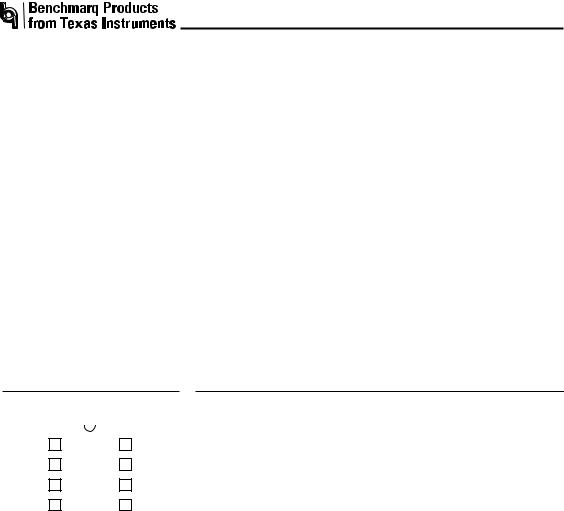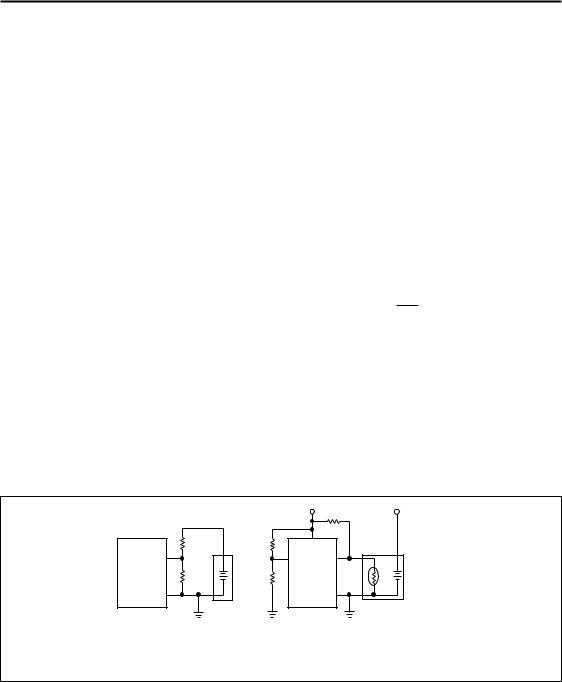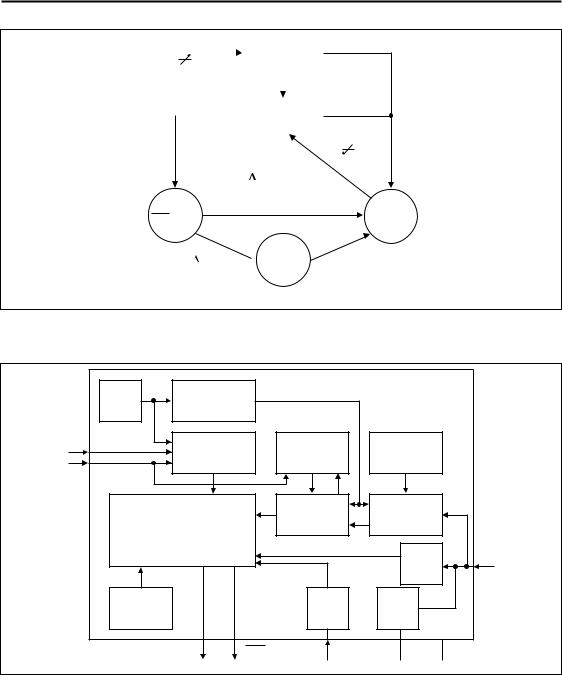Texas Instruments DV2002L2, BQ2002PN, BQ2002FSNTR, BQ2002FSN, BQ2002FPN Datasheet
...
bq2002/F
NiCd/NiMH Fast-Charge Management ICs
Features
Fast charge of nickel cadmium or nickel-metal hydride batteries
Direct LED output displays charge status
Fast-charge termination by -∆V, maximum voltage, maximum temperature, and maximum time
Internal band-gap voltage reference
Optional top-off charge
Selectable pulse trickle charge rates
Low-power mode
8-pin 300-mil DIP or 150-mil SOIC
General Description
The bq2002 and bq2002/F Fast-Charge ICs are low-cost CMOS battery-charge controllers providing reliable charge termination for both NiCd and NiMH battery applications. Controlling a current-limited or constant-current supply allows the bq2002/F to be the basis for a cost-effective stand-alone or system-integrated charger. The bq2002/F integrates fast charge with optional top-off and pulsed-trickle control in a single IC for charging one or more NiCd or NiMH battery cells.
Fast charge is initiated on application of the charging supply or battery replacement. For safety, fast charge is inhibited if the battery temperature and voltage are outside configured limits.
Fast charge is terminated by any of the following:
Peak voltage detection (PVD)
Negative delta voltage (-∆V)
Maximum voltage
Maximum temperature
Maximum time
After fast charge, the bq2002/F optionally tops-off and pulse-trickles the battery per the pre-configured limits. Fast charge may be inhibited using the INH pin. The bq2002/F may also be placed in low-standby-power mode to reduce system power consumption.
The bq2002F differs from the bq2002 only in that a slightly different set of fast-charge and top-off time limits is available. All differences between the two ICs are illustrated in Table 1.
Pin Connections |
|
|
|
Pin Names |
|
|
|
|
|||||||||||
|
|
|
|
|
|
|
|
|
|
|
|
TM |
Timer mode select input |
TS |
Temperature sense input |
||||
|
TM |
|
1 |
8 |
|
CC |
|
|
|
||||||||||
|
|
|
|
|
|
|
|
|
|
|
|
|
|
||||||
|
|
|
|
2 |
7 |
|
|
|
|
|
|
LED |
Charging status output |
VCC |
Supply voltage input |
||||
|
LED |
|
|
INH |
|
|
|
||||||||||||
|
|
|
|
|
|
|
|
|
|
|
|
|
|
||||||
|
BAT |
|
3 |
6 |
|
VCC |
|
|
|
BAT |
Battery voltage input |
INH |
Charge inhibit input |
||||||
|
|
|
|
|
|
|
|
|
|
|
CC |
Charge control output |
|||||||
VSS |
|
4 |
5 |
|
TS |
|
|
|
VSS |
System ground |
|
||||||||
|
|
|
|
|
|
|
|
|
|
|
|
|
|||||||
|
|
|
|
8-Pin DIP or |
|
|
|
|
|
|
|
|
|
|
|
|
|
|
|
|
|
|
|
Narrow SOIC |
|
|
|
|
|
|
|
|
|
|
|
|
|
|
|
|
|
|
|
|
PN-200201.eps |
|
|
|
|
|
|
|
|
|
|
|
|||
|
|
|
|
|
|
|
|
|
|
|
|
||||||||
|
|
|
|
|
|
|
|
|
|
|
|||||||||
bq2002/F Selection Guide |
|
|
|
|
|
||||||||||||||
|
|
|
|
|
|
|
|
|
|
|
|
|
|
|
|||||
Part No. |
|
TCO |
|
HTF |
|
LTF |
|
-∆V |
PVD |
Fast Charge |
tMTO |
Top-Off |
|
Maintenance |
|||||
|
|
|
0.5 VCC |
|
|
|
|
|
|
|
|
|
|
C/2 |
160 |
C/32 |
|
C/64 |
|
bq2002 |
|
None |
|
None |
|
|
|
|
|
1C |
80 |
C/16 |
|
C/64 |
|||||
|
|
|
|
|
|
|
|
|
|
|
|
|
2C |
40 |
None |
|
C/32 |
||
|
|
|
0.5 VCC |
|
|
|
|
|
|
|
|
|
|
C/2 |
160 |
C/32 |
|
C/64 |
|
bq2002F |
|
None |
|
None |
|
|
|
|
|
1C |
100 |
C/16 |
|
C/64 |
|||||
|
|
|
|
|
|
|
|
|
|
|
|
|
2C |
55 |
None |
|
C/32 |
||
SLUS131–JANUARY 1999 D
1

bq2002/F
Pin Descriptions
TM |
Timer mode input |
|
A three-level input that controls the settings |
|
for the fast charge safety timer, voltage ter- |
|
mination mode, top-off, pulse-trickle, and |
|
voltage hold-off time. |
LED |
Charging output status |
|
Open-drain output that indicates the charging |
|
status. |
BAT |
Battery input voltage |
|
The battery voltage sense input. The input to |
|
this pin is created by a high-impedance re- |
|
sistor divider network connected between |
|
the positive and negative terminals of the |
|
battery. |
VSS |
System ground |
TS |
Temperature sense input |
|
Input for an external battery temperature |
|
monitoring thermistor. |
VCC |
Supply voltage input |
|
5.0V ±20% power input. |
INH |
Charge inhibit input |
|
When high, INH suspends the fast charge in |
|
progress. When returned low, the IC re- |
|
sumes operation at the point where initially |
|
suspended. |
CCCharge control output
An open-drain output used to control the charging current to the battery. CC switching to high impedance (Z) enables charging current to flow, and low to inhibit charging current. CC is modulated to provide top-off, if enabled, and pulse trickle.
Functional Description
Figure 2 shows a state diagram and Figure 3 shows a block diagram of the bq2002/F.
Battery Voltage and Temperature
Measurements
Battery voltage and temperature are monitored for maximum allowable values. The voltage presented on the battery sense input, BAT, should represent a single-cell potential for the battery under charge. A resistor-divider ratio of
RB1 = N - 1
RB2
is recommended to maintain the battery voltage within the valid range, where N is the number of cells, RB1 is the resistor connected to the positive battery terminal, and RB2 is the resistor connected to the negative battery terminal. See Figure 1.
Note: This resistor-divider network input impedance to end-to-end should be at least 200kΩ and less than 1 MΩ.
A ground-referenced negative temperature coefficient thermistor placed near the battery may be used as a lowcost temperature-to-voltage transducer. The temperature sense voltage input at TS is developed using a resistorthermistor network between VCC and VSS. See Figure 1.
|
|
|
VCC |
|
PACK + |
|
|
|
|
|
RT |
||
|
RB1 |
R3 |
VCC |
|
|
|
BAT |
|
|
TM |
TS |
|
|
bq2002/F |
|
|
bq2002/F |
N |
||
RB2 |
R4 |
T |
||||
|
|
|
||||
|
|
|
|
|
C |
|
VSS |
|
|
|
VSS |
|
|
BAT pin connection |
Mid-level |
|
Thermistor connection |
|||
|
|
setting for TM |
|
|
||
NTC = negative temperature coefficient thermistor.
Fg2002/F01.eps
Figure 1. Voltage and Temperature Monitoring and TM Pin Configuration
2

bq2002/F
|
Chip on |
|
|
|
|
Battery |
|||
V |
|
|
4.0V |
|
|
|
|
Voltage? |
|
CC |
|
|
|
|
|
|
|
||
|
|
|
|
V |
BAT |
< 2V |
|
||
|
|
|
|
|
|
|
|||
|
VTS > VCC/2 |
|
|
|
|
|
|||
|
|
|
|
Battery |
|||||
|
|
|
|
|
|
|
|
||
|
|
|
|
|
|
|
Temperature? |
||
|
|
|
|
|
|
|
|
|
|
V |
BAT |
> 2V |
|
|
VTS < VCC/2
Fast
LED = Low
V |
BAT |
> 2V |
|
|
VTS < VCC/2 ((PVD or - V or
Maximum Time-Out) and TM = high)
V |
2V |
CC |
|
Trickle
LED = Z
(PVD or - V or  Maximum Time-Out) and TM = high
Maximum Time-Out) and TM = high
Top-off
LED = Z
Maximum Time-Out |
||
or V |
BAT |
> 2V |
or |
|
|
|
|
|
VTS < VCC/2
SD2002/F01
Figure 2. State Diagram
|
Clock |
|
|
|
|
OSC |
Phase |
|
|
|
|
|
Generator |
|
|
|
|
TM |
Timing |
|
Sample |
Voltage |
|
|
|
||||
|
Control |
|
History |
Reference |
|
INH |
|
|
|
|
|
|
|
|
∆ |
A to D |
|
|
|
|
PVD, - V |
Converter |
|
|
Charge-Control |
|
ALU |
||
|
State Machine |
|
|
|
|
|
|
|
|
|
MCV |
|
|
|
|
|
Check |
|
|
|
|
|
BAT |
Power-On |
|
TCO |
Power |
||
Reset |
|
Check |
Down |
||
|
CC |
LED |
TS |
VCC |
VSS |
|
|
||||
|
|
|
|
|
Bd2002f.eps |
Figure 3. Block Diagram
3

bq2002/F
|
|
|
|
|
|
|
|
|
|
|
|
|
|
|
|
|
|
|
|
|
|
|
|
|
|
|
|
|
|
|
|
|
|
|
|
|
|
|
|
|
|
|
|
|
|
|
|
|
|
|
|
|
|
|
|
|
|
|
|
|
|
|
|
|
|
|
|
|
|
|
|
|
|
|
|
|
|
|
|
|
|
|
|
|
|
|
|
|
|
|
|
|
|
|
|
|
|
|
|
|
|
|
|
|
|
VCC = 0 |
|
Fast Charging |
|
|
|
Top-Off |
|
|
|
|
|
|
|
Pulse-Trickle |
Fast Charging |
|
||||||||||||||||||||||||||||||||||||
|
|
|
|
|
|
|
|
|
|
|
|
|
|
|
|
|
|
|
|
|
(optional) |
|
|
|
|
|
|
|
|
|
|
|
286 s |
|
|
|||||||||||||||||
CC Output |
|
|
|
|
|
|
|
|
|
|
|
|
|
|
|
|
|
|
286 s |
|
|
|
|
|
|
|
|
|
|
|
|
|
||||||||||||||||||||
|
|
|
|
|
|
|
|
|
|
|
|
|
|
|
|
|
|
|
|
|
|
|
|
|
|
|
|
|
|
|
||||||||||||||||||||||
|
|
|
|
|
|
|
|
|
|
|
|
|
|
|
|
|
|
|
|
|
|
|
|
|
|
|
|
|
|
|||||||||||||||||||||||
|
|
|
|
|
|
|
|
|
|
|
|
|
|
|
|
|
|
|
|
|
|
|
|
|
|
|
|
|
|
|
|
|
|
|
|
|
|
|
|
|
|
|
|
|
|
|
|
|
|
|
|
|
|
|
|
|
|
|
|
|
|
|
|
|
|
|
|
|
|
|
4576 |
s |
|
|
|
|
|
|
|
|
|
|
|
|
|
|
|
See |
|
|
|
|
|||||||||||||
|
|
|
|
|
|
|
|
|
|
|
|
|
|
|
|
|
|
|
|
|
|
|
|
|
|
|
|
|
|
|
|
Table 1 |
|
|
|
|
|
|
||||||||||||||
|
|
|
|
|
Charge initiated by application of power |
|
|
|
|
|
|
|
|
|
|
|
|
|
|
|
|
|
|
|
|
|
|
|
|
|
||||||||||||||||||||||
|
|
|
|
|
|
|
|
|
|
|
|
|
|
|
|
|
|
|
|
|
|
Charge initiated by battery replacement |
|
|
|
|||||||||||||||||||||||||||
|
|
|
|
|
|
|
|
|
|
|
|
|
|
|
|
|
|
|
|
|
|
|
|
|
||||||||||||||||||||||||||||
|
|
|
|
|
|
|
|
|
|
|
|
|
|
|
|
|
|
|
|
|
|
|
|
|
|
|
|
|
|
|
|
|
|
|
|
|
|
|
|
|
|
|
|
|
|
|
|
|
|
|
|
|
LED |
|
|
|
|
|
|
|
|
|
|
|
|
|
|
|
|
|
|
|
|
|
|
|
|
|
|
|
|
|
|
|
|
|
|
|
|
|
|
|
|
|
|
|
|
|
|
|
|
|
|||
|
|
|
|
|
|
|
|
|
|
|
|
|
|
|
|
|
|
|
|
|
|
|
|
|
|
|
|
|
|
|
|
|
|
|
|
|
|
|
|
|
|
|
|
|
|
|
|
|
|
|
|
|
|
|
|
|
|
|
|
|
|
|
|
|
|
|
|
|
|
|
|
|
|
|
|
|
|
|
|
|
|
|
|
|
|
|
|
|
|
|
|
|
|
|
|
|
|
|
|
|
|
|
|
TD2002F1.eps |
|
|
|
|
|
|
|
|
|
|
|
|
|
|
|
|
|
|
|
|
|
|
|
|
|
|
|
|
|
|
|
|
|
|
|
|
|
|
|
|
|
|
|
|
|
|
|
|
|
|
|
|
|
|
Figure 4. Charge Cycle Phases
Starting A Charge Cycle
Either of two events starts a charge cycle (see Figure 4):
1.Application of power to VCC or
2.Voltage at the BAT pin falling through the maximum cell voltage VMCV where
VMCV = 2V ±5%.
If the battery is within the configured temperature and voltage limits, the IC begins fast charge. The valid battery voltage range is VBAT < VMCV. The valid temperature range is VTS > VTCO where
VTCO = 0.5 VCC ±5%.
If the battery voltage or temperature is outside of these limits, the IC pulse-trickle charges until the next new charge cycle begins.
Fast charge continues until termination by one or more of the five possible termination conditions:
Peak voltage detection (PVD)
Negative delta voltage (-∆V)
Maximum voltage
Maximum temperature
Maximum time
Table 1. Fast-Charge Safety Time/Hold-Off Table
|
|
|
|
Typical Fast-Charge |
|
|
|
|
|
|
|
|
|
and Top-Off |
|
|
|
Pulse- |
|
|
|
|
|
Time Limits |
|
|
|
||
Corresponding |
|
|
(minutes) |
Typical PVD |
|
Pulse- |
Trickle |
||
Fast-Charge |
|
|
|
|
and -∆V Hold-Off |
Top-Off |
Trickle |
Period |
|
|
bq2002 |
bq2002F |
|||||||
Rate |
|
TM |
Termination |
Time (seconds) |
Rate |
Rate |
(ms) |
||
|
|
|
|
|
|
|
|
|
|
C/2 |
|
Mid |
PVD |
160 |
160 |
600 |
C/32 |
C/64 |
9.15 |
|
|
|
|
|
|
|
|
|
|
1C |
|
Low |
PVD |
80 |
100 |
300 |
C/16 |
C/64 |
18.3 |
|
|
|
|
|
|
|
|
|
|
2C |
|
High |
-∆V |
40 |
40 |
150 |
Disabled |
C/32 |
18.3 |
|
|
|
|
|
|
|
|
|
|
Notes: |
Typical conditions = 25°C, VCC = 5.0V. |
|
|
|
|
|
|||
|
Mid = 0.5 * VCC ±5V |
|
|
|
|
|
|
||
|
Tolerance on all timing is ±20%. |
|
|
|
|
|
|||
4
